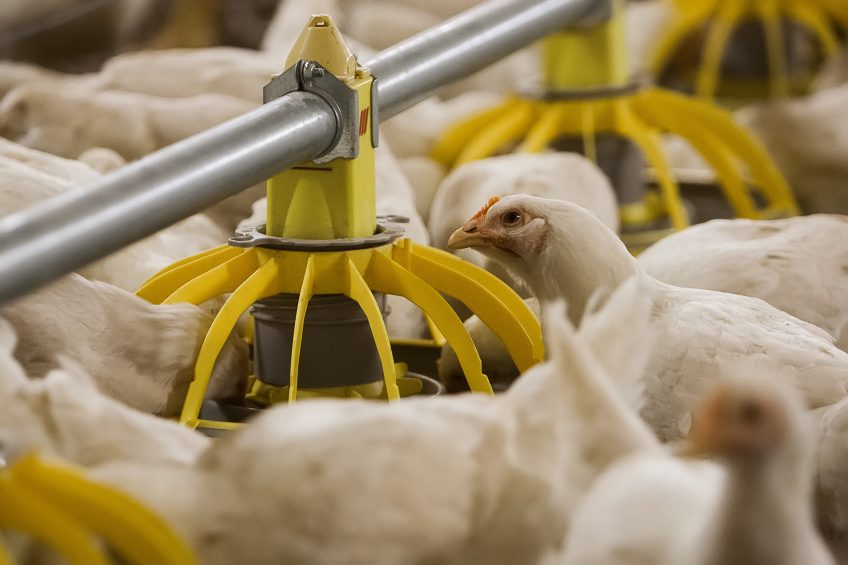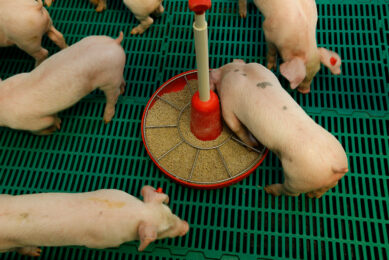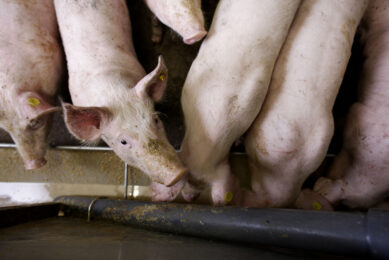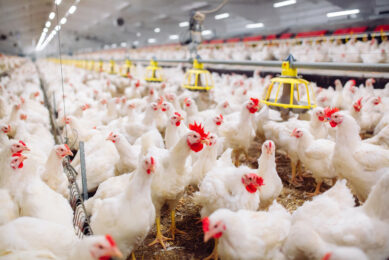Optimising nutrient absorption in broiler diets

Modern animal production is constantly facing the contradiction of raising animals with high quality feed on the one hand and at the lowest possible cost on the other. To achieve this, lysolecithin is added to feed in order to promote the absorption of nutrients, particularly the absorption of the dietary lipids.
Upon ingestion, dietary lipids are first released from the feed matrix and emulsified through the motility of the stomach. This primary emulsion then enters the small intestine where it is further emulsified by the action of bile salts. Subsequently the colipase-lipase complex attaches to the emulsion droplet interface and starts to hydrolyse the triglycerides into monoglycerides and free fatty acids. The hydrolytic reaction products then reassemble into mixed micelles, which migrate through the intestinal lumen to the enterocytes. There they disintegrate and their constituents are absorbed.
The well-known effect of lysophospholipids on all 3 steps in the fat digestion process (emulsification, hydrolysis and absorption) has been thoroughly researched. The additional effect of lysophospholipids on the absorption of different nutrients has especially been highlighted in recent studies. This effect can be explained by increasing cell membrane permeability and was further confirmed in multiple animal trials.
These insights led to the present study to fully exploit the benefits of lysolecithin usage in feed. It was investigated if the addition of selected quantities of synthetic emulsifier and monoglycerides to lysolecithin as a mixture (the product, Lysoforte Extend) could improve lipid emulsification and hydrolysis, respectively.
Lipid emulsification
Lysolecithin and the mixture of lysolecithin, monoglycerides and synthetic emulsifier, were first dispersed in rapeseed oil (0.5%). Next, 50 g of the different rapeseed oil dispersions and a rapeseed oil control were mixed with a salt solution for five seconds and the emulsion stability was recorded over time. Emulsion stability was significantly improved by the mixture as after 30 minutes the emulsion stability of oil (8%) was improved to 39% with lysolecithin and to 84% with the mixture.
To evaluate their effect on lipid hydrolysis, lysolecithin and the mixture of lysolecithin, monoglycerides and synthetic emulsifier were subjected to a lipid hydrolysis model. The products were first dispersed in animal fat (1.2% lysolecithin). After addition of simulated intestinal fluid, mixing and addition of pancreatic extract, the contents were incubated (2h, 40°C). During incubation, samples of each digest were analysed for lipid composition and the apparent rate constant for free fatty acid release was determined. The addition of lysolecithin or the mixture had a significant impact on the free fatty acid release rate. Addition of lysolecithin increased the free fatty acid release rate by 41%. Even though the same amounts of lysolecithin were added, the mixture was even more successful and increased the free fatty acid release rate by 50%.
Absorption of monoglycerides and fatty acids
The impact of lysolecithin and the mixture of lysolecithin, monoglycerides and synthetic emulsifier on the absorption of monoglycerides and free fatty acids was assessed in a lipid absorption model. The samples obtained with the hydrolysis model were diluted in simulated intestinal fluid and applied on a monolayer of differentiated Caco-2 cells. At the start and after incubation, the fluid was subjected to lipid analysis. The absorption of monoglycerides was 121% higher in lysolecithin and 142% higher in the mixture than in the control (monoglyceride absorption of 133 mg/g). Similarly, the absorption of free fatty acids was 72% higher in lysolecithin and 77% higher in the mixture than in the control (free fatty acid absorption of 133 mg/g). The observed improvements confirm that lysolecithin is a key contributor to improve lipid absorption. As both the emulsification and hydrolysis process was significantly higher with the mixture than with lysolecithin alone, more fatty acids and other hydrolysis products would reach the enterocytes and the mixture would thus result in higher absorption of the hydrolysis products overall.
Broiler performance
In a broiler performance trial, a total of 216 day-old male Ross 308 broilers were fed either a basal diet fulfilling all dietary requirements (positive control, Table 1), a basal diet with lower metabolisable energy (negative control) or a basal diet with lower metabolisable energy with 500 ppm of the mixture of lysolecithin, monoglycerides and synthetic emulsifier; Lysoforte Extend dry, produced by Kemin Europa. At the end of the starter period (14 d), average body weight and daily gain were significantly higher (18 g/bird and 1.3 g/bird/day, respectively) in birds fed the diet with the mixture than in those fed the negative control diet (Table 2).
Over the whole rearing period (0 – 42 d), the highest average body weight and average daily gain were observed for birds fed the diet with the mixture. Additionally, during the starter period, the FCR was significantly lower (-7 points) in birds fed the diet with the mixture than in birds fed the negative control diet (Figure 1). Similarly, the FCR over the whole rearing period was reduced by 6 points with the addition of the mixture. Therefore, due to a better nutrient digestion and absorption, birds fed a diet supplemented with the mixture were able to compensate for an energy gap of 60 kcal/kg in the starter diet and of 80 kcal/kg in the grower and finisher diets, respectively.
Figure 1 – Feed conversion ratio of broilers fed a basal diet (positive control), a basal diet with lower energy (negative control) or a basal diet with lower energy with 500 ppm of a mixture of lysolecithin, monoglycerides and synthetic emulsifier.*

Destination of the absorbed lipids
At the end of the rearing period, two chickens per pen were sacrificed to calculate carcass yield, breast yield and abdominal fat pad content. The abdominal fat pad content of birds fed the diet with the mixture was significantly lower than that of birds fed the positive control diet or the negative control diet. The latter suggests that addition of the mixture resulted in a better utilisation of the absorbed nutrients for meat production.
The addition of selected quantities of synthetic emulsifier and monoglycerides to lysolecithin and applying it as a mixture results in improved lipid emulsification and hydrolysis. With the use of this unique ratio of active components, diets could be reduced with 60 to 80 kcal/kg, while maintaining the same performance and slaughter yields of the broilers. Moreover, as a result of better utilisation of the absorbed nutrients for meat production, birds fed a diet with the mixture had a lower abdominal fat pad than those fed the positive control diet.






